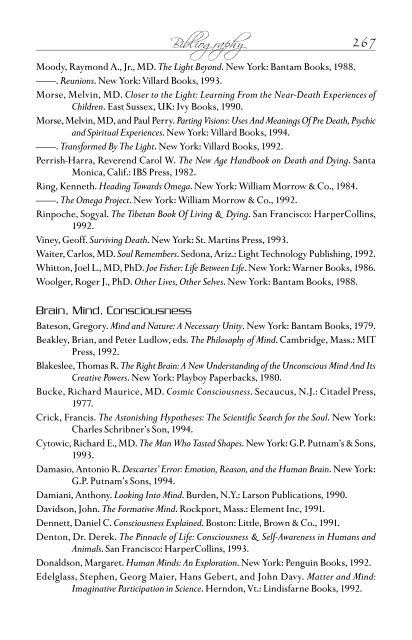edgar-mitchell
edgar-mitchell
edgar-mitchell
Create successful ePaper yourself
Turn your PDF publications into a flip-book with our unique Google optimized e-Paper software.
134<br />
The Way of the Explorer<br />
in space-time, and that particles each “know” what the other is doing, is<br />
even more problematic. In any event, the experiment conclusively demonstrated<br />
that matter and information have attributes that remain correlated<br />
nonlocally. It’s this mysterious nonlocality that brings new insight into<br />
a number of problems, including those of many enigmatic, subjective<br />
attributes of consciousness. This paradox also demonstrated that the methods<br />
of science are sufficiently powerful to uncover the flawed assumptions in<br />
the Newtonian and Cartesian thought structures.<br />
Because the rules of quantum theory are supposed to apply to all matter,<br />
not just subatomic matter, by extension of this ubiquitous, interconnected<br />
“resonance,” it suggests that all nature is in some sense wavelike, “fieldlike,”<br />
and “mindlike,” in a way that isn’t yet fully understood. The experimental<br />
results imply analogies to the silly superstitions of some medieval (and<br />
modern) mystics, and are somewhat akin to the Platonic idea of the real,<br />
unmanifest world as made up of ideas and perfect form. Resonance and<br />
nonlocality are fundamental clues to all psychic functioning, and are attributes<br />
of the newly discovered quantum hologram, which is discussed in a<br />
subsequent chapter.<br />
The second major paradox arising early in the history of quantum theory<br />
still hasn’t been answered to the satisfaction of most physicists. It’s another<br />
thought experiment called the Schrödinger’s Cat Paradox. Erwin<br />
Schrödinger formulated the wave equation that bears his name, and the<br />
paradox derives from use of the wave equation. The experiment is especially<br />
relevant to our understanding of consciousness, as it arises directly<br />
from the entanglement of existence and knowing; from confusing the map<br />
with the territory.<br />
By following the Einstein-Bohr procedure of minutely dissecting<br />
thought experiments, one can reveal hidden traps in the vast labyrinth<br />
that produced this paradox. The traps all have to do with how we organize<br />
information in our mind/brain and give it meaning, and the subtle dividing<br />
line between internal and external events. Because the Schrödinger<br />
wave equation allows one to compute the probable values of something’s<br />
attributes (generally referred to as its state), this thought experiment concerns<br />
the state of a cat. It’s a peculiar imaginary situation, but one that’s<br />
immensely important.<br />
Suppose a cat is placed in a box that contains a radioactive substance,<br />
a flask of poison, and a trigger mechanism. This odd collection is arranged<br />
in such a way that the radioactive decay of the substance creates a 50/50<br />
probability that the vial of poison is broken, and if it is, the cat is instantly<br />
killed. Particles do not emerge from decaying radioactive materials on a<br />
uniform time scale, but randomly, and such that half of the total emitted<br />
particles will escape in a period called the half-life of the radioactive substance.<br />
Half of the remaining half will escape in the second half-life interval,


